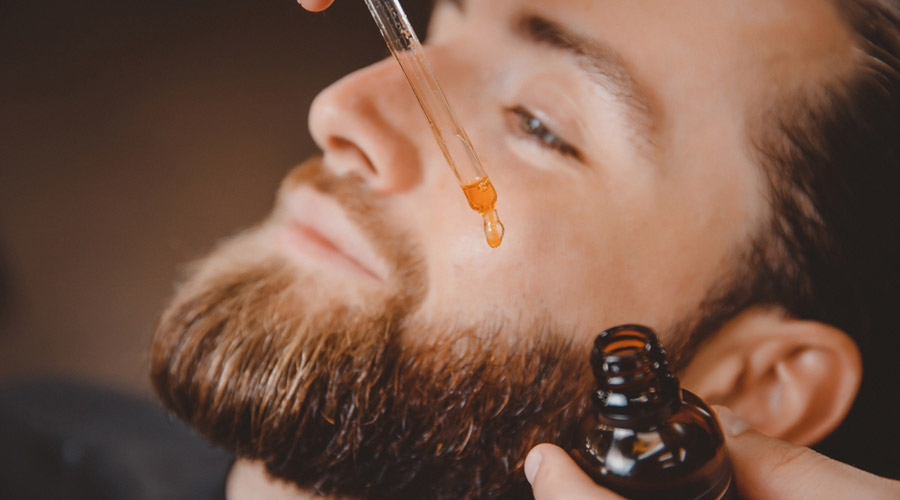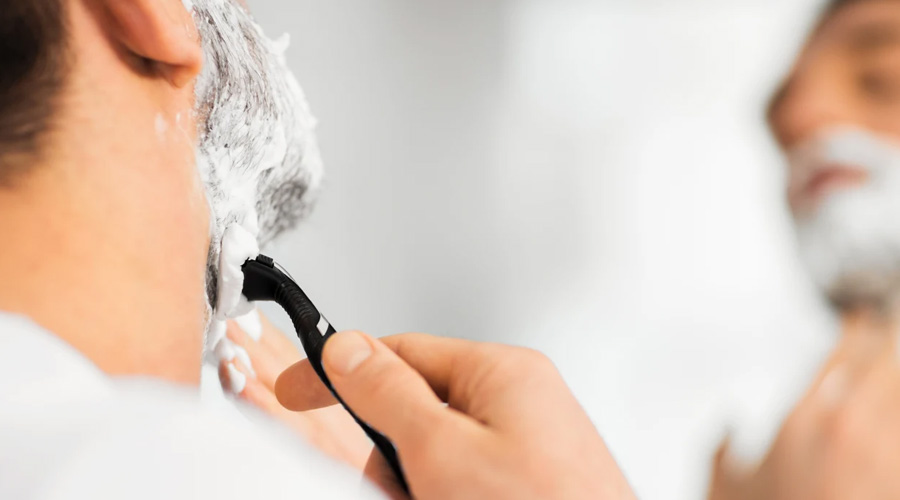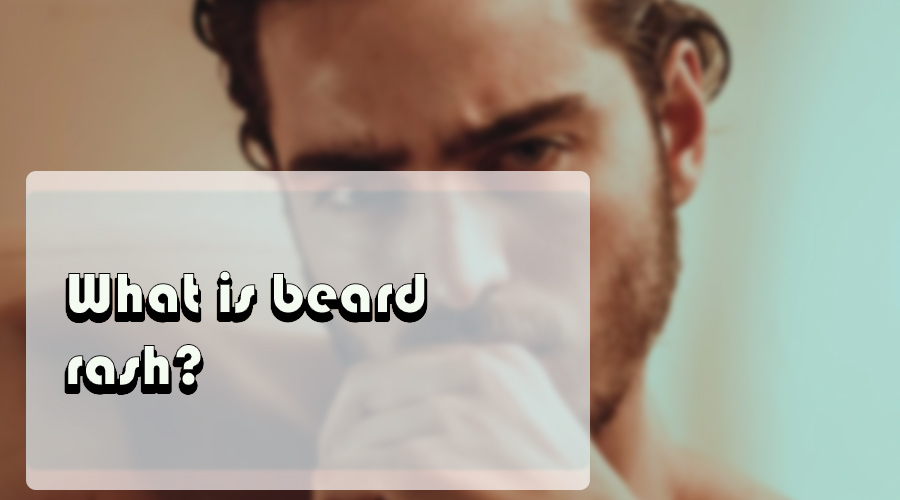Beard rash, also known as beardruff, is a skin condition that can affect the face, neck, and chest area. It can also lead to blisters. The condition is caused by an allergy to the proteins in facial hair, which are present in both shaven and bearded men. Other causes may include allergies, dry skin, and certain types of hair follicles. Hair follicles’ inflammatory response to environmental factors leads to an itchy beard.
Symptoms of beard itch may include skin irritation and redness itching, and a thick, scaly coating over the affected area. Treatment typically involves avoiding things that trigger the itch and using over-the-counter topical treatments or antibiotics. One can apply cream or lotion to moisturize facial hair and alleviate the symptoms.
What causes an itchy beard?

itching of the beard is one of the most common skin problems. Most people think that it is caused by a fungus, but this is not always the case. There are many factors that trigger itchy facial hair, including skin type, hormones, soap use, and climate.
There is no one answer to what exactly causes an itchy beard as everyone may experience different conditions. However, some of the most common triggers are dry skin, ingrown hairs, scalp psoriasis, seborrheic clen cycle for beginners dermatitis, fungal overgrowth, beard dandruff, razor bumps, and irritation from soap products. In addition, there are a few lifestyle factors that can also contribute to itchy facial hair, such as wearing too much cologne or using harsh soaps.
Seborrheic dermatitis. Seborrheic dermatitis is a common skin condition that affects the sebaceous glands. The condition is caused by an overproduction of oil and sweat. The skin becomes itchy, red, and swollen. Seborrheic dermatitis may be mild or severe. Treatment involves using prescription or over-the-counter medications, topical creams, or surgery.
Other potential causes for an itchy beard involve allergic reactions. In most cases, the cause is unknown and requires a professional diagnosis.
Prevent and treat beard rash

Beard rash is a common skin problem that can occur on the face, neck, or chest. The rash can be itchy and red and may appear as small bumps or patches. It is a common skin problem that can be caused by a number of factors, including shaving and other forms of hair removal, environmental allergies, and contact dermatitis.
There are a few things you can do to treat or prevent beard rash caused by the facial hair, including using a moisturizer and sunscreen, avoiding hot environments, taking breaks from shaving every few weeks, and avoiding rubbing the area excessively.
The best way to prevent beard itch is to keep your beard hairs clean and free of debris. If you do get a beard rash, you can treat it with over-the-counter creams or antibiotics. But always remember to see and consult your doctor before
Apply topical creams

Beard rash can be a frustrating experience for anyone, but it can be made a whole lot worse if the rash is not treated promptly. Luckily, there are many topical creams available that can help to relieve the itch and swelling associated with these rashes. Some of the most popular topical creams for beard rash include zinc oxide, hydrocortisone, and calamine lotion.
Topical creams for rashes caused by the beard can be a helpful way to relieve symptoms, but it is important to use them in the correct way. Some tips for using topical creams for an itchy beard include applying the cream at bedtime, using a light moisturizer after application, and waiting 48 hours before washing the area.
Glycolic and salicylic acids for beard rash. Glycolic acid and salicylic acid are two acids that have been used for years to treat beard rash. Both acids work by breaking down the skin’s surface proteins, which can help to relieve inflammation and itching. Glycolic acid is more gentle and may be preferable for some people, while salicylic acid is more effective but can cause irritation.
Other popular topical treatments available that can help to relieve an itchy rash include tea tree oil, aloe vera, calamine lotion, petroleum jelly, and witch hazel. It is important to select a cream that is specifically designed for this kind of rash and to apply it regularly to help prevent the condition from worsening.
Moisturize your beard

There are a few different ways to moisturize your beard in order to help treat beard rash. Some people prefer to use oils or balms while others use water and alcohol. However, there are also many available treatments on the market. Some of the most popular ingredients include jojoba oil, shea butter, and almond oil. While these ingredients might seem like they would be beneficial for the skin underneath the beard, they could also cause an allergic reaction in some people.
Beard moisturizers can be used to treat rashes caused by the beard. A moisturizer will help keep the skin around the beard hydrated, which can help reduce inflammation and itching. Keep in mind that moisturizers should not be used as a substitute for proper beard care, including washing and conditioning the beard hair. Whichever treatment method you choose, be sure to apply the moisturizer daily to keep your beard looking healthy and free from irritation.
If you are experiencing a beard rash, it is important to consult with a dermatologist before using any moisturizing products.
Know when to see a dermatologist

There is no one answer to this question as it depends on the individual’s beard hair growth pattern, skin type and other factors. However, it’s important to see a dermatologist if you develop a beard rash. The rash may be caused by an infection, a skin problem or a reaction to an ingredient in the beard oil or soap you’re using. If the rash is severe, the dermatologist may require treatment with antibiotics.
Beard rash is a common skin problem that can be caused by a variety of factors. If you experience redness, itching, and scaling on your beard, it’s best to see a dermatologist to determine the cause and possible treatment. Skin experts may suggest laser hair removal or laser treatment to avoid beard rash caused by harsh shaving.
Press pause on your shaving routine

The popularity of shaving has caused many men to suffer from beard itch. This problem can be treated with a few simple steps. Shaving does not cause beard rash, but the irritation and inflammation it causes is a common cause. First, avoid using razor blades that are dull or worn out. Second, don’t shave too close to the skin. Third, use a moisturizing soap and hot water before rinsing off your beard.
So, it’s not necessarily shaving that causes beard rash, but the way how one would shave. It also involves the use of reliable razors, facial hair scissors, and shaving cream. However, the condition can be different from one person to another. If you feel that even after shaving carefully you still develop a beard itch, there’s a need for you to pause shaving and see what happens from there.
Keep your beard clean

Beard rash is a common problem that can be caused by many different things. One of the most common causes is dirt and debris getting trapped in the beard hair and then being rubbed against the skin. This can cause an allergic reaction and, in some cases, a rash.
Beard rash is a common skin problem that can develop on the face, neck, and upper chest. There are a few things you can do to help keep your beard clean and free of rash-causing bacteria and fungus. To reduce your risk of developing beard rash, follow these tips
- Rinse your beard once or twice a day with warm water and a mild soap.
- Use a soft brush to remove any built-up debris or oil from the beard.
- If you use a beard trimmer, clean the blades regularly with hot water and soap.
- Use beard wash or moisturizer to keep your beard in good shape.
Conclusion
In conclusion, beard rash is a common problem that can be caused by a variety of factors. It is typically characterized by red, itchy skin around the beard area. The best way to treat beard rash is to identify the underlying cause and address it. If the rash is caused by an underlying skin condition, then treatment may include topical medications or antibiotics. If the rash is caused by an allergic reaction, then the best course of action is to identify and avoid the allergen.
FAQ
What does beard burn look like?
Beard burn is a condition where the beard oil or soap you use causes your skin to become red, irritated, and sometimes blistering. The cause of beard burn can be either from the chemicals in the beard oil or soap, or from the friction that occurs when you are using them. If you are using an unscented beard oil, some people recommend using a moisturizer underneath to avoid any potential problems.
How do you treat beard rash?
Beard rash is a common skin condition that can be caused by a variety of factors, including exposure to the sun and wind. The rash may look like red bumps or patches on the face, neck, or chest. It can be uncomfortable and unsightly, and sometimes requires treatment with topical creams or oral medication. Here are some tips for treating beard rash:
Avoid exposure to the sun and wind: These conditions are known contributors to beard rash.
Apply a topical cream or ointment: Many treatments available at drugstores work well for beard rash. Look for products that contain petroleum jelly or menthol to help soothe the skin.
Take ibuprofen: If the rash is severe, take ibuprofen as prescribed by your doctor. Ibuprofen can relieve pain and inflammation in the beard area.
What helps beard rash after shaving?
We all know that shaving can cause razor burn and even a beard rash. But what helps to relieve the symptoms? Many people swear by using an astringent, such as witch hazel or aloe vera, after shaving. Others recommend applying a moisturizer or cream, like Dr. Bronner’s soap, immediately following the shave.
What causes rashes around the neck?
Rashes around the neck are caused by a variety of things, some more common than others. Some of the more common causes of rashes around the neck include: an allergic reaction to a plant, dust mites, viral infections (such as chickenpox or HPV), and contact dermatitis from wearing clothing that is too tight against the skin.
Other less common causes can include thyroid problems, hormonal changes, and skin cancer. In most cases, rashes around the neck respond well to treatment with over-the-counter products or prescription medications. If you are concerned about a rash around your neck, it is best to see a wellness physician for an evaluation.
Which ointment is best for face rash?
Some people prefer an emollient ointment such as Vaseline or petroleum jelly because it helps to soothe and protect the skin. Others may prefer a topical steroid ointment because it can help reduce redness and inflammation. There are also creams that contain both an emollient and a topical steroid, which is ideal for people who are looking for the best possible combination of care.


